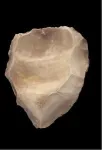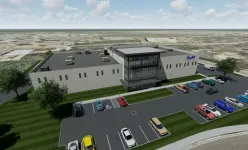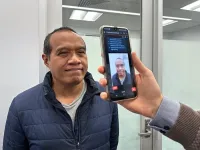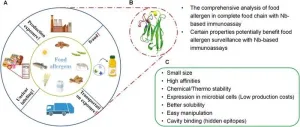(Press-News.org) FOR IMMEDIATE RELEASE
In studies with genetically engineered mice, Johns Hopkins Medicine researchers say they have identified a potentially new biological target involving Aplp1, a cell surface protein that drives the spread of Parkinson’s disease-causing alpha-synuclein.
The findings, published May 31 in Nature Communications, reveal how Aplp1 connects with Lag3, another cell surface receptor, in a key part of a process that helps spread harmful alpha-synuclein proteins to brain cells. Those protein buildups are hallmarks of Parkinson’s disease.
Notably, the researchers say, Lag3 is already the target of a combination cancer drug approved by the U.S. Food and Drug Administration (FDA) that uses antibodies to “teach” the human immune system what to seek and destroy.
“Now that we know how Aplp1 and Lag3 interact, we have a new way of understanding how alpha-synuclein contributes to the disease progression of Parkinson’s disease,” says Xiaobo Mao, Ph.D., associate professor of neurology at the Johns Hopkins University School of Medicine and a member of the Institute for Cell Engineering. “Our findings also suggest that targeting this interaction with drugs could significantly slow the progression of Parkinson’s disease and other neurodegenerative diseases.”
Mao co-led the research along with Ted Dawson, M.D., Ph.D., Leonard and Madlyn Abramson Professor in Neurodegenerative Diseases at the Johns Hopkins University School of Medicine and director of the Johns Hopkins Institute for Cell Engineering, Valina Dawson, Ph.D. and Hanseok Ko, Ph.D., professors of neurology at the school of medicine and members of the Institute for Cell Engineering.
Long-standing studies have shown that by clumping together and forming protein deposits, misfolded alpha-synuclein proteins journey from brain cell to brain cell, killing those responsible for producing a neurotransmitter called dopamine, and causing Parkinson’s disease to progress through a type of “programmed” cell death that Johns Hopkins researchers have identified. The process, parthanatos (from the Greek word for “death”), leads to impairments in movement, emotional regulation and thinking.
Aplp1’s bond with Lag3 on the cell’s surface enables healthy brain cells to absorb traveling clumps of alpha-synuclein, leading to cell death, the researchers say.
In mouse studies published in 2016 and 2021, Mao and Dawson’s team identified Lag3’s role in binding with alpha-synuclein proteins, causing Parkinson’s disease to spread. However, those studies indicated that another protein was partially responsible for the cell’s absorption of misfolded alpha-synuclein.
“Our work previously demonstrated that Lag3 wasn’t the only cell surface protein that helped neurons absorb alpha-synuclein, so we turned to Aplp1 in our most recent experiments,” says Valina Dawson.
To determine whether Aplp1 indeed contributed to the spread of harmful alpha-synuclein proteins, researchers used a line of genetically engineered mice lacking either Aplp1 or Lag3 or both Aplp1 and Lag3. In mice without Aplp1 and Lag3, cell absorption of the harmful alpha-synuclein protein dropped by 90%. After injecting mice with the Lag3 antibody, they found that this drug also blocks the interaction of Aplp1 and Lag3, meaning healthy brain cells could no longer absorb disease-causing alpha-synuclein clumps.
The researchers say the Lag3 antibody nivolumab/relatlimab, a drug FDA approved in 2022 for cancer treatment, could play a role in preventing cells from absorbing alpha-synuclein.
“The anti-Lag3 antibody was successful in preventing further spread of alpha-synuclein seeds in the mouse models and exhibited better efficacy than Lag3-depletion because of Aplp1’s close association with Lag3,” Ted Dawson says.
This research has potential applications in treating other neurodegenerative conditions that have no cures, Mao says. In Alzheimer’s disease, which is associated with symptoms of memory loss, mood instability and muscle problems, tau proteins become misfolded and clump together in neurons at high levels, worsening the condition. In Alzheimer’s research, Mao says scientists could try to target Lag3 — which also binds with the dementia-related tau protein — with the same antibody.
With the success of using the Lag3 antibody in mice, Ted Dawson says the next steps would be to conduct anti-Lag3 antibody trials in mice with Parkinson’s disease and Alzheimer’s disease. The Johns Hopkins researchers are also looking into how they could prevent unhealthy cells from releasing disease-causing alpha-synuclein in the first place.
Other researchers on this study are Hao Gu, Donghoon Kim, Yasuyoshi Kimura, Ning Wang, Enquan Xu, Ramhari Kumbhar, Xiaotian Ming, Haibo Wang, Chan Chen, Shengnan Zhang, Chunyu Jia, Yuqing Liu, Hetao Bian, Senthilkumar Karuppagounder, Fatih Akkentli, Qi Chen, Longgang Jia, Heehong Hwang, Su Hyun Lee, Xiyu Ke, Michael Chang, Amanda Li, Jun Yang, Cyrus Rastegar, Manjari Sriparna, Preston Ge, Saurav Brahmachari, Sangjune Kim, Shu Zhang, Haiqing Liu, Sin Ho Kweon, Mingyao Ying and Han Seok Ko from Johns Hopkins; Yasushi Shimoda from the Nagaoka University of Technology; Martina Saar and Ulrike Muller from Heidelberg University; Creg Workman and Dario Vignali of the University of Pittsburgh School of Medicine and Cong Liu of the Chinese Academy of Sciences.
This work was supported by grants from the National Institutes of Health (R01NS107318, R01AG073291, R01AG071820, 1135 RF1NS125592, K01AG056841, R21NS125559, R01NS107404, P01AI108545, R01AI144422), the Parkinson’s Foundation, the Maryland Stem Cell Research Foundation, the American Parkinson Disease Association, the Uehara Memorial Foundation, the JPB Foundation, the Adrienne Helis Malvin Medical Research Foundation, and the Parkinson’s Disease Foundation.
DOI: 10.1038/s41467-024-49016-3
END
New study suggests cancer drug could be used to target protein connection that spurs Parkinson’s disease
2024-06-17
ELSE PRESS RELEASES FROM THIS DATE:
More than 1 in 10 patients at FQHCs experience major social risk factors
2024-06-17
A first-of-its-kind study found high rates of food insecurity, housing insecurity, financial strain, and/or a lack of transportation among patients at federally qualified health centers, particularly patients who were low-income or from racial/ethnic minority populations.
Federally qualified health centers (FQHCs) offer primary care services to 1 in 11 Americans, the majority of whom are low-income and/or underinsured and may not otherwise receive this care. While prior research has shown that 70 percent of FQHCs screen for social ...
Artificial intelligence accurately screens heart failure patients for clinical trial eligibility
2024-06-17
Generative Artificial Intelligence (Gen AI) can rapidly and accurately screen patients for clinical trial eligibility, according to a new study from Mass General Brigham researchers. Such technology could make it faster and cheaper to evaluate new treatments and, ultimately, help bring successful ones to patients.
Investigators assessed the accuracy and cost of a Gen AI process they named RAG-Enabled Clinical Trial Infrastructure for Inclusion Exclusion Review (RECTIFIER), that identifies patients who meet criteria for enrollment in ...
Unlocking the mystery behind the performance decline in a promising cathode material
2024-06-17
The first generation of lithium-ion batteries for electric vehicles has been a remarkable success story. Yet, the question arises: What changes to battery materials will spur further advances to extend driving range and lower costs?
A better positive electrode, or cathode, for lithium-ion batteries has been the focus of intense past research. The cathode is one of the main components in batteries. Several candidates for cathode materials offer the prospect of batteries with much higher energy storage, leading to longer driving range. However, the capacity, or amount of current flowing out within a given time, tends to decline rapidly with charge-discharge cycling for reasons ...
A call for renaming clinical research partnerships
2024-06-17
PHILADELPHIA (June 17, 2024) - In a recently published opinion piece in BMJ Open, “Rhetoric of Research: A Call for Renaming the Clinical Research Partnership,” authors from Penn Nursing and Georgetown University School of Nursing, present a compelling argument for rethinking the language used to describe participants in clinical research. The opinion calls for a shift from the traditional term “patient participant” to “participant partner,” emphasizing the crucial role of participants in ...
SwRI breaks ground on new hypersonic engine research facility
2024-06-17
SAN ANTONIO — June 17, 2024 —Southwest Research Institute (SwRI) today celebrated the groundbreaking of the Center for Accelerating Materials and Processes (CAMP), a new facility that will support research and development for tomorrow’s high-speed aerospace engines.
“This project will help ensure the U.S. is a leader in high-speed propulsion research and development,” said Dr. Barron Bichon, director of SwRI’s Materials Engineering Department. “SwRI is committed to advancing this vital technology on behalf of Texas and the nation.”
Market forces including growth in global defense, air travel, ...
International Gemini Observatory and Subaru combine forces to discover first ever pair of merging quasars at cosmic dawn
2024-06-17
Since the very first instant after the Big Bang the Universe has been expanding. This means that the early Universe was considerably smaller and early-formed galaxies were more likely to interact and merge. Galaxy mergers fuel the formation of quasars — extremely luminous galactic cores where gas and dust falling into a central supermassive black hole emit enormous amounts of light. So when looking back at the early Universe astronomers would expect to find numerous pairs of quasars in close proximity to each other as their host galaxies undergo mergers. However, they have been surprised ...
Repurposed drug may help stabilize vision in rare disease
2024-06-17
Roughly 50 families scattered across the world share ultra-rare variants in a particular gene. Silent for years, the inherited mutations make themselves known when patients reach the fourth decade of life. Changes in vision start a cascade of symptoms. Five to 20 years later, the illness is fatal.
Researchers at Washington University School of Medicine in St. Louis have dedicated many years to understanding the rare condition known as retinal vasculopathy with cerebral leukoencephalopathy and systemic manifestations, or RVCL-S, with the aim of developing a treatment ...
Face screening tool detects stroke in seconds
2024-06-17
A new smartphone face-screening tool could help paramedics to identify stroke in seconds – much sooner and more accurately than is possible with current technologies.
Strokes, which affect millions of people globally, occur when the blood supply to part of the brain is interrupted or reduced, which prevent brain tissue from getting oxygen and nutrients. A few minutes of delay can result in permanent damage to the brain cells.
A team of biomedical engineers at RMIT University developed the AI capabilities behind the software technology and has published their results ...
Making this Parkinson's drug is just turtles all the way down (video)
2024-06-17
WASHINGTON, June 17, 2024 — L-DOPA is the best drug we have for Parkinson’s disease, but its molecular mirror image, D-DOPA, causes dangerous side effects. Making L-DOPA without also making D-DOPA is surprisingly hard and requires a specific kind of molecule to pull off. But that specific molecule must be made from a different and equally specific molecule. In this video, our host, George Zaidan, explains how one of the winners of the 2001 Nobel Prize in Chemistry pulled it off, and why "chiral synthesis," as it's called, is really just turtles all the way down. https://youtu.be/_cb09XB07LQ?si=BuMEI5fOuHmuQlkZ
Reactions is a video series ...
Camelid nanobodies: Transforming food allergen analysis
2024-06-17
Recent advancements show nanobodies from camelid antibodies excel in food allergen detection with superior stability, specificity, and cost-effectiveness. This innovative approach aims to improve accuracy and efficiency, crucial for preventing severe allergic reactions. The study highlights nanobodies' potential in reliable immunoassays, addressing rising food allergies and enhancing safety measures.
Food allergies pose significant health risks, affecting millions worldwide, with the prevalence rising over the past decades. Traditional detection methods, such as monoclonal and polyclonal antibodies, are often costly, labor-intensive, and prone to cross-reactions. The need for ...









